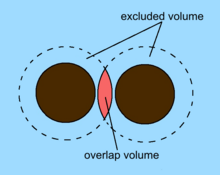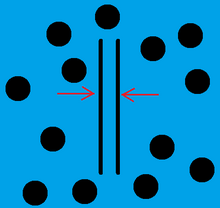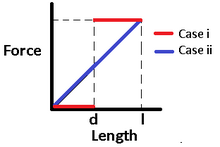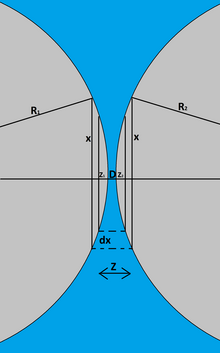User:Brezhurley/sandbox
| This is a Wikipedia user page. This is not an encyclopedia article or the talk page for an encyclopedia article. If you find this page on any site other than Wikipedia, you are viewing a mirror site. Be aware that the page may be outdated and that the user in whose space this page is located may have no personal affiliation with any site other than Wikipedia. The original page is located at http://en.wikipedia.org/wiki/User:Brezhurley/sandbox. |
A depletion force is an entropic force that arises between large colloidal particles that are suspended in a dilute solution of smaller, nonadsorbing sols, called depletants.[1] The depletion force arises from an increase in osmotic pressure of the surrounding solution when colloidal particles get close enough such that depletant sols cannot fit inbetween them.[2] Depletion forces are generally attractive, resulting in flocculation, but may be repulsive at larger distances and higher depletant concentration.[1]

Depletant sols include polymers, micelles, ink, mud, or paint dispersed in a continuous phase.[1][3]
Causes
[edit]Sterics
[edit]The system of colloids and depletants in solution is typically modeled by treating the large colloids and small depletants as dissimilarly sized hard spheres.[1] Hard spheres are characterized as non-interacting and inpenetrable spheres. These two fundamental properties of hard spheres are described mathematically by the hard-sphere potential. The hard-sphere potential imposes steric constraint around large spheres which in turn gives rise to excluded volume, that is, volume that is unavailable for small spheres to occupy.[2]
Hard-sphere potential
[edit]In a colloidal dispersion, the colloid-colloid interaction potential is approximated as the interaction potential between two hard spheres. For two hard spheres of diameter of , the interaction potential as a function of interparticle separation is:
called the hard-sphere potential where is the center-to-center distance between the spheres.[4]
If both colloids and depletants are in a dispersion, there is interaction potential between colloidal paticles and depletant particles that is described similarly by the hard-sphere potential.[2] Again, approximating the particles to be hard-spheres, the interaction potential between colloids of diameter and depletant sols of diameter is:
where is the center-to-center distance between the spheres. Typically, depletant particles are very small compared to the colloids so
The underlying consequence of the hard-sphere potential is that dispersed colloids cannot penetrate each other and have no mutual attraction or repulsion.
Excluded Volume
[edit]
When both large colloidal particles and small depletants are in a suspension, there is a region which surrounds every large colloidal particle that is unavailable for the centers of the depletants to occupy. This steric restriction is due to the colloid-depletant hard-sphere potential.[2][4] The volume of the excluded region is:
where is the diameter of the large spheres and is the diameter of the small spheres.
When the large spheres get close enough, the excluded volumes surrounding the spheres intersect. The overlapping volumes result in a reduced excluded volume, that is, an increase in the total free volume available to small spheres.[1][3] The reduced excluded volume, can be written:
where is the width of the lens-shaped region of overlap volume formed by spherical caps. The available volume for small spheres is the difference between the total volume of the system and the excluded volume. To determine to available volume for small spheres, there are two distinguishable cases: first, the separation of the large spheres is big enough so that the small spheres can penetrate in between them; second, the large spheres are close enough so that small spheres cannot penetrate between them.[2]
In the latter case small spheres are are depleted from the interparticle region between large spheres and a depletion force ensues.
Thermodynamics
[edit]The depletion force is described as an entropic force because it is fundamentally a manifestation of the second law of thermodynamics, which states that a system a system tends to increase its entropy.[2] The gain in translational entropy of the depletants, owing to the increased available volume, is much greater than the loss of entropy from flocculation of the colloids.[3] This lowers the Helmholtz free energy and causes colloidal flocculation to happen spontaneously. The system of colloids and depletants in a solution is modeled as a canonical ensemble of hard spheres for statistical determinations of thermodynamic quantities.[2]
Entropy and Helmholtz Energy
[edit]The total volume available for small spheres increases when the excluded volumes around large spheres overlap. The increased volume allotted for small spheres allows them greater translational freedom which increases their entropy.[1] Because the canonical ensemble is an athermal system at a constant volume the Helmholtz free energy is written:
where is the Hemholtz free energy, is the entropy and is the temperature. The system's net gain in entropy is positive from increased volume, thus the Hemholtz free energy is negative and depletion flocculation happens spontaneously.
The free energy of the system is obtained from a statistical definition of Helmholtz free energy:
where is the partition function for the cannonical ensemble. The partition function contains statistical information that describes the canonical ensemble including its total volume, the total number of small spheres, the volume available for small spheres to occuppy, and the de Broglie wavelength.[2] If hard-spheres are assumed, the partition function is:
The volume available for small spheres, was calculated above. is the number of small spheres and is the de Broglie wavelength. Substituting into the statistical definintion, the Helmholtz free energy now reads:
Knowing how the Helmholtz free energy changes with distance between two large spheres gives the magnitude of the depletion force, :[2]
Osmotic Pressure
[edit]The depletion force is an effect of increased osmotic pressure in the surrounding solution. When colloids get sufficiently close, that is when their excluded volumes overlap, depletants are expelled from the interparticle region. This region between colloids then becomes a phase of pure solvent. When this occurs, there is a higher depletant concentration in the surrouding solution than in the interparticle region.[2][3] The resulting density gradient gives rise to an osmotic pressure that is anisotropic in nature, acting on the outer sides of the colloids and promoting flocculation.[5] If the hard-sphere approximation is employed, the osmotic pressure is:
where is osmotic pressure and is number density of small sheres and is Boltzmann's constant.
The Asakura-Oosawa Model
[edit]Depletion forces were first described by Sho Asakura and Fumio Oosawa in 1954. In their model, the force is always considered to be attractive. Additionally, the force is considered to be proportional to the osmotic pressure. The Asakura-Oosawa model assumes low macromolecule densities and that the density distribution, , of the macromolecules is constant. Asakura and Oosawa described four cases in which depletion forces would occur. They first described the most general case as two solid plates in a solution of macromolecules. The principles for the first case were then extended to three additional cases. [5]

Solid Plates in a Solution of Macromolecules
[edit]In the first case,two solid plates are placed in a solution of rigid spherical macromolecules.[6] If the the distance between two plates, , is smaller than the diameter of solute molecules, , then no solute can enter between the plates. This results in pure solvent existing between the plates. The difference in concentration of macromolecules in the solution between the plates and the bulk solution causes a force equal to the osmotic pressure to act on the plates. In a very dilute and monodisperse solution the force is defined by

where is the force, and is the total number of solute molecules. The force causes the entropy of the macromolecules to increase and is attractive when [5]
Rod-like Macromolecules
[edit]Asakura and Oosawa described the second case as consisting of two plates in a solution of rod like macromolecules. The rod like macromolecules are described as having a length, , where , the area of the plates. As the length of the the rods increases, the concentration of the rods between the plates is decreased as it becomes more difficult for the rods to enter between the plates due to steric hindrances. As a result, the force acting on the plates increases with the length of the rods until it becomes equal to the osmotic pressure. [6]
Plates in a Solution of Polymers
[edit]The third case described by Asakura and Oosawa is two plates in a solution of polymers. Due to the size of the polymers, the concentration of polymers in the neighborhood of the plates is reduced, which result the conformational entropy of the polymers being decreased. The case can be approximated by modeling it as diffusion in a vessel with walls which absorb diffusing particles. The force, , can then be calculated according to:
In this equation is the attraction from the osmotic effect. is the repulsion due to chain molecules confined between plates. is on order of , the mean end-to-end distance of chain molecules in free space.[2]
Large Hard Spheres in a Solution of Small Hard Spheres
[edit]The final case described by Asakura and Oosawa describes two large, hard spheres of diameter , in a solution of small, hard spheres of diameter . If the distance between the center of the spheres, , is less than ,then the small spheres are excluded from the space between the large spheres. This results in the area between the spheres having a reduced concentration of small spheres and a reduced entropy. The reduced entropy causes a force to act upon the large spheres pushing them together. [2]
Improvements Upon the Asakura and Oosawa Model
[edit]Derjaguin Approximation
[edit]Theory
[edit]Asakura and Oosawa assumed low concentrations of macromolecules. However, at high concentrations of macromolecules, structural correlation effects in the macromolecular liquid become important. Additionally, the repulsive interaction strength strongly increases for large values of . (large radius/small radius) [5] In order to account for these issues, the Derjaguin approximation, which is valid for any type of force law, has been applied to depletion forces. The Derjaguin approximation relates the force between two spheres to the force between two plates. The force is then integrated between small regions on one surface and the opposite surface, which is assumed to be locally flat. [2]

Equations
[edit]If there are two spheres of radii and on the axis, and the spheres are distance apart, where is much smaller than and , then the force, , in the direction is
In this equation, , and is the normal force per unit area between two flat surfaces distance apart.
When the Derjaguin approximation is applied to Depletion Forces, and 0<h<2Rs , then the depletion force given by the Derjaguin approximation is
In this equation, is the geometrical factor, which is set to 1, and , the interfacial tension at the wall-fluid interface.[2]
Density functional theory
[edit]Theory
[edit]Asakura and Oosawa assumed a uniform particle density, which is true in a homogenous solution. However if an external potential is applied to a solution, then the uniform particle density is disrupted, making Asakura and Oosawa's assumption invalid. Density functional theory accounts for variations in particle density by using the grand canonical potential. The grand canonical potential, which is a state function for the grand canonical ensemble, is used to calculate the probability density for microscopic states in macroscopic state. When applied to depletion forces, the grand canonical potential calculates the local particle densities in a solution.[2]
Equations
[edit]Density functional theory states that when any fluid is exposed to an external potential, , then all equilibrium quantities become functions of number density profile, . As a result, the total free energy is minimized. The Grand canonical potential ,, is then written
where is the chemical potential, is the temperature, and is the helmholtz free energy. [7]
Measurement and Experimentation
[edit]Depletion forces have been observed and measured using a variety of instrumentation including atomic force microscopy, optical tweezers, and hydrodynamic force balance machines.
Atomic Force Microscopy
[edit]Atomic force microscopy (AFM) is commonly used to directly measure the magnitude of depletion forces. This method uses the deflection of a very small cantilever contacting a sample which is measured by a laser. The force required to cause a certain amount of beam deflection can be determined from the change in angle of the laser. The small scale of AFM allows for dispersion particles to be measured directly yielding a relatively accurate measurement of depletion forces. [8]
Optical Tweezers
[edit]The force required to separate two colloid particles can be measured using optical tweezers. This method uses a focused laser beam to apply an attractive or repulsive force on dielectric micro and nanoparticles. This technique is used with dispersion particles by applying a force which resists depletion forces. The displacement of the particles is then measured and used to find the attractive force between the particles.
Hydrodynamic Force Balance
[edit]HFB machines measure the strength of particle interactions using liquid flow to separate the particles. This method is used to find depletion force strength by adhering to a static plate one particle in a dispersion particle doublet and applying shear force through fluid flow. The drag created by the dispersion particles resists the depletion force between them, pulling the free particle away from the adhered particle. A force balance of the particles at separation can be used to determine the depletion force between the particles. [9]
Colloidal Destabilization
[edit]Mechanism
[edit]Depletion forces are used extensively as a method of destabilizing colloids. By introducing particles into a colloidal dispersion, attractive depletion forces can be induced between dispersed particles. These attractive interactions bring the dispersed particles together resulting in flocculation. [10] [11] This destabilizes the colloid as the particles are no longer dispersed in the liquid but concentrated in floc formations. Floc are then easily removed through filtration processes leaving behind a non-dispersed, pure liquid. [12]
Water Treatment
[edit]The use of depletion forces to initiate flocculation is a common process in water treatment. The relatively small size of dispersed particles in waste water renders typical filtration methods ineffective. However, if the dispersion was to be destabilized and flocculation occur, particles can then be filtered out to produce pure water. Therefore, coagulants and flocculants are typically introduced to waste water which create these depletion forces between the dispersed particles. [12] </ref>[10]
Winemaking
[edit]Some wine production methods also use depletion forces to remove dispersed particles from wine. Unwanted colloidal particles can be found in wine originating from the must or produced during the winemaking process. These particles typically consist of carbohydrates, pigmentation molecules, or proteins which may adversely affect the taste and purity of the wine. [13] Therefore, flocculants are often added to induce floc precipitation for easy filtration.
Common Flocculants
[edit]The table below lists common flocculants along with their chemical formulas, net electrical charge, molecular weight and current applications.
| Flocculant | Chemical Formula | Charge | Molecular Weight (AMU/molecule) | Application |
|---|---|---|---|---|
| Aluminum Sulfate (Alum) | Al2(SO4)3 | Ionic | 342.15 | Water Treatment |
| Ferrous Sulfate | FeSO4 | Ionic | 151.91 | Water Treatment |
| Polyvinylpolypyrrolidone (PVPP) | (C6H9NO)n | Nonionic | 2.5 | Wine and Beer Clarification |
| Poly(acrylamide-co-sodium acrylate) | (C6H9NO3Na3 | Anionic | 10,000-1 Million | Water Treatment and Paper Production |
| Polyethylene Oxide | C2nH4n+2On+1 | Nonionic | 4-8 Million | Paper Production |
Biological Systems
[edit]There are suggestions that depletion forces may be a significant contributor in some biological systems, specifically in membrane interactions between cells or any membranous structure. [11] With concentrations of large molecules such as proteins or carbohydrates in the extracellular matrix, it is likely some depletion force effects are observed between cells or vesicles that are very close. However, due to the complexity of most biological systems, it is difficult to determine how much these depletion forces influence membrane interactions. [11] Models of vesicle interactions with depletion forces have been developed, but these are greatly simplified and their applicability to real biological systems is questionable.
References
[edit]- ^ a b c d e f Mao, Y. (May 1995). "Depletion force in colloidal systems". Physica A: Statistical and Theoretical Physics. 222 (1–4): 10–24. doi:10.1016/0378-4371(95)00206-5. hdl:1874/22114. S2CID 121387079.
{{cite journal}}: Unknown parameter|coauthors=ignored (|author=suggested) (help)CS1 maint: date and year (link) - ^ a b c d e f g h i j k l m n o "University of Ljubljana department of physics" group="Faculty of mathematics and physics">Mravlak, Marko. "Depletion Force".
{{cite web}}: Missing or empty|url=(help) - ^ a b c d Butt, Hans-Jürgen (2006). Physics and chemistry of interfaces (2., rev. and enl. ed.). Weinheim: Wiley-VCH-Verl. pp. 116–117. ISBN 978-3-527-40629-6.
{{cite book}}: Unknown parameter|coauthors=ignored (|author=suggested) (help) - ^ a b Biben, Thierry (1996). "Depletion effects in binary hard-sphere fluids". Journal of Physics: Condensed Matter. 8 (50): 10799–10800. doi:10.1088/0953-8984/8/50/008. hdl:1874/10416. S2CID 250884220.
{{cite journal}}: Unknown parameter|coauthors=ignored (|author=suggested) (help) - ^ a b c d Bechinger, C.; Rudhardt, D.; Leiderer, P.; Roth, R.; Dietrich, S. (1 November 1999). "Understanding Depletion Forces beyond Entropy". Physical Review Letters. 83 (19): 3960–3963. doi:10.1103/PhysRevLett.83.3960. S2CID 14043180.
- ^ a b Asakura, Sho; Oosawa, Fumio (1 January 1954). "On Interaction between Two Bodies Immersed in a Solution of Macromolecules". The Journal of Chemical Physics. 22 (7): 1255–1256. doi:10.1063/1.1740347.
- ^ Götzelmann, B.; Evans, R.; Dietrich, S. (NaN undefined NaN). "Depletion forces in fluids". Physical Review E. 57 (6): 6785–6800. doi:10.1103/PhysRevE.57.6785.
{{cite journal}}: Check date values in:|date=(help) - ^ Milling, A. J.; Kendall, K. “Depletion, Adsorption, and Structuring of Sodium Poly(acrylate) at the Water-Silica Interface: An Atomic Force Microscopy Force Study” Langmuir. 2000. 16: Pgs. 5106-5115.
- ^ Piech, M.; Weronski, P.; Wu, X.; Walz, J.Y. “Prediction and Measurement of the Interparticle Depletion Interaction Next to a Flat Wall” Journal of Colloid and Interface Science. 2002. 247: Pgs. 327-341.
- ^ a b Casey, T.J. “Unit Treatment Processes in Water and Wastewater Engineering”. Aquavarra Reasearch Ltd. 2006. Chp. 3, Pgs. 28-29.
- ^ a b c Roth, R.; Gotzelmann, B.; Dietrich, S. “Depletion Forces Near Curved Surfaces”. American Physical Society. 1998. 82:2 Pgs. 448-451.
- ^ a b Bratby, J. “Coagulation and Flocculation in Water and Wastewater Treatment”. IWA Publishing. London: 2006. Pgs. 3-6.
- ^ Moreno, Juan; Peinado, Rafael. “Enological Chemistry”. Elsevier Inc. San Diego: 2012. Pgs. 325-326.










![{\displaystyle V'_{\text{E}}=V_{\text{E}}-{\frac {2\pi l^{2}}{3}}{\bigg [}{\frac {3\left(D+d\right)}{2}}-l{\bigg ]}}](https://wikimedia.org/api/rest_v1/media/math/render/svg/16273304edab376ba03389d60d73df35de02d079)










































![{\displaystyle F(h)=-\pi \epsilon \left(R_{B}+R_{S}\right){\big [}p(\rho )(2R_{S}-h)+\gamma (\rho ,\infty ){\big ]}}](https://wikimedia.org/api/rest_v1/media/math/render/svg/6b40da7cc68bf09d5baabf071ea0cca119a6c9b9)




![{\displaystyle \Omega \left({\big [}\rho (R){\big ]};\mu ,T\right)}](https://wikimedia.org/api/rest_v1/media/math/render/svg/271a03762a7db2dbac2b9db165a95b17ada384fa)
![{\displaystyle \Omega \left({\big [}\rho (R){\big ]};\mu ,T\right)=A\left({\big [}\rho (R){\big ]};T\right)-\int d^{3}R{\big [}\mu -V(R){\big ]}\rho (R)}](https://wikimedia.org/api/rest_v1/media/math/render/svg/90a27d7e171157d56a9e0a17e478ffd9157d3492)

![{\displaystyle A[\rho ]}](https://wikimedia.org/api/rest_v1/media/math/render/svg/ed42a98fcb04c2a88a96116428fdd88381b12621)